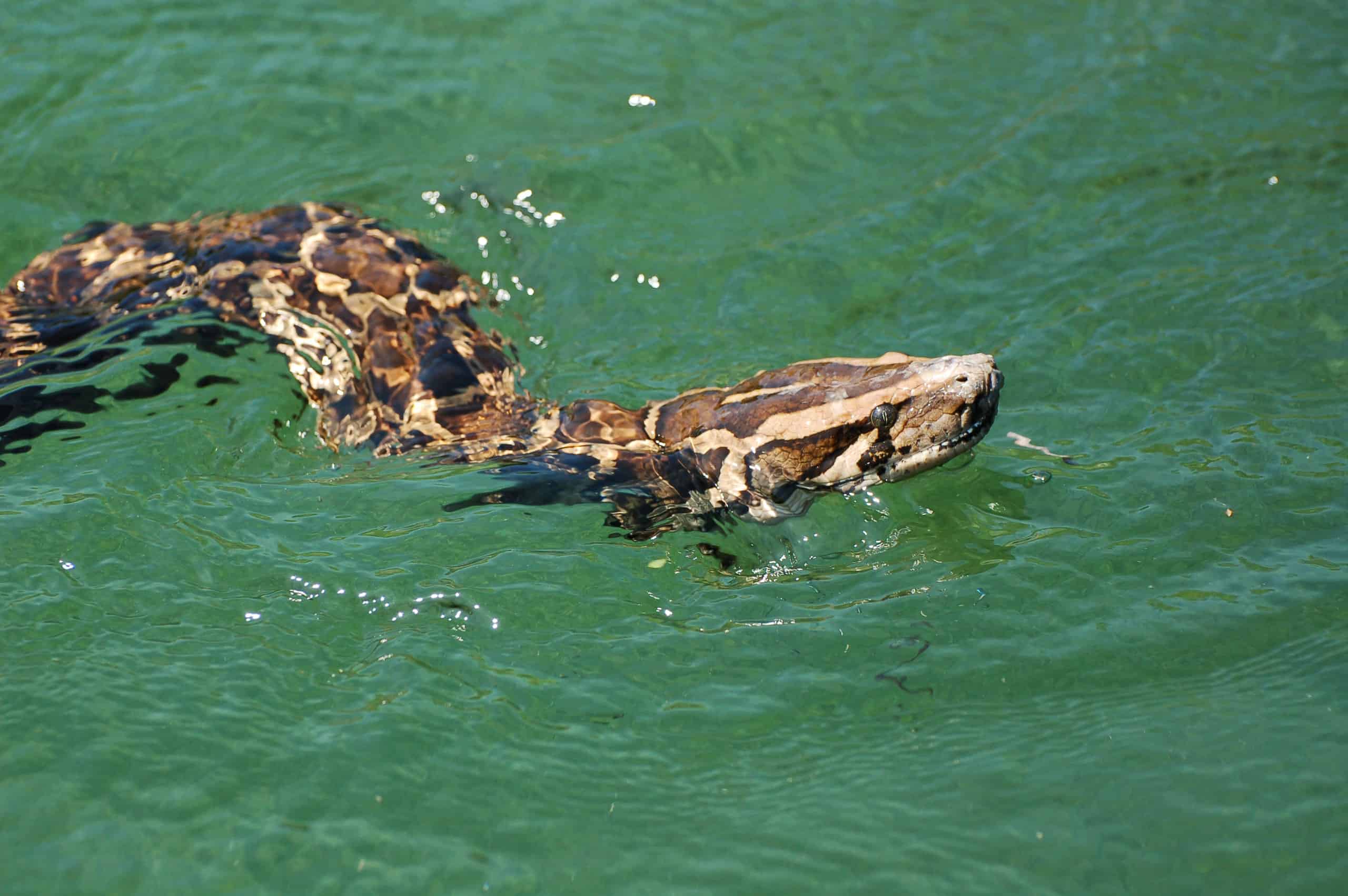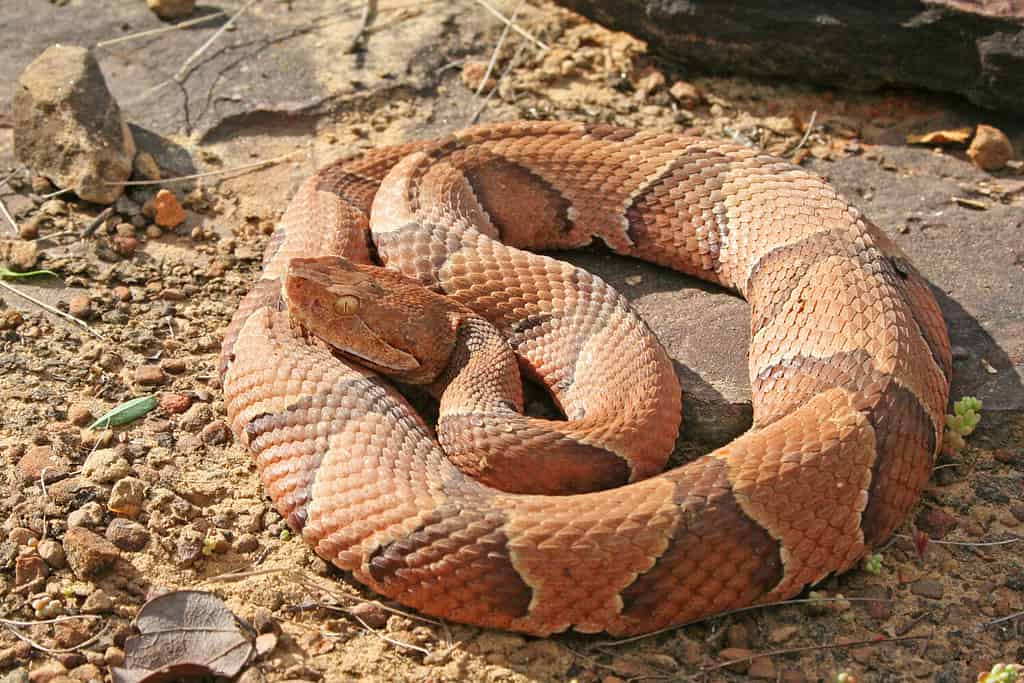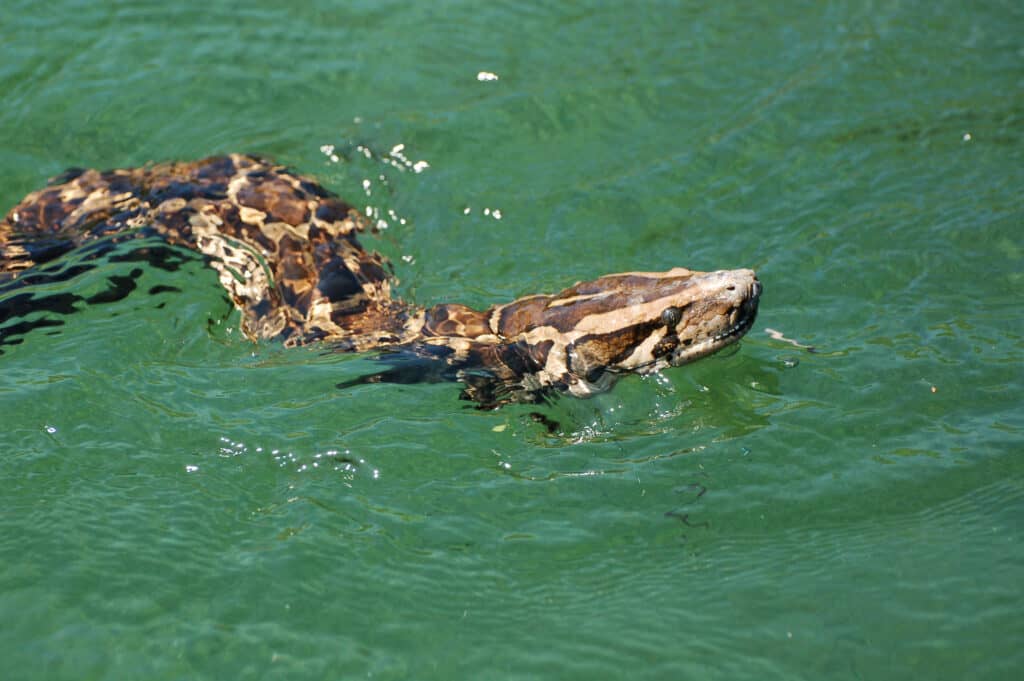Continue reading for our analysis...

Although Florida is known for its alligators, there are other reptiles in the state that appear in the most inconvenient places. In the video below, a man discovers a snake he thought was dead has sprung to life!
What Types Of Snakes Live In Florida?

.
©Creeping Things/Shutterstock.com
There are many different types of snakes in Florida, some of which are venomous and some that are non-venomous. The types of snakes to be aware if you live in or plan to visit “The Sunshine State” include copperheads, corn snakes, Burmese pythons, central African rock pythons, kingsnakes, rough green snakes, milk snakes, water snakes, pit vipers, and boa constrictors.
Are Pythons Venomous?

©Firman Wahyudin/Shutterstock.com
A popular non-native snake in Florida is the non-venomous Burmese python. These snakes grow 10 to 16 feet in length, and their bodies are littered with dark brown irregular marks that have black borders. Their base coloration is lighter, kind of tan, yellowish, or cream. If these snakes feel a threat, they do bite, and while the smaller, younger snakes may not hurt as much when it’s a big snake, the bite is painful. They are non-venomous, which means you wouldn’t require anti-venom, but you could receive a serious injury.
How Large Do Pythons Get?

Spider ball pythons can live up to 50 years.
©Sanne Romijn Fotografie/Shutterstock.com
Adults typically measure between three to six feet in length on average, although some specimens have been documented exceeding 7 feet, with a maximum recorded length of 8 feet. In Florida, the average weight for this species falls within the range of two to four pounds, while certain larger individuals can tip the scales at over ten pounds.
Given that the eastern diamondback holds the title of the world’s largest rattlesnake, it follows that any state within its habitat can boast of hosting the largest rattlesnake species. The most substantial specimens of this rattlesnake can be found in North Carolina, South Carolina, Florida, Georgia, Alabama, Mississippi, and Louisiana.
Is It Normal For a Python to Swim in a Pool?

Like many modern snakes, the Burmese python is a strong swimmer.
©Heiko Kiera/Shutterstock.com
Pythons are a species of snake that are native to the Middle East and South Asia but have become an invasive species in Florida. They were originally brought to the area as exotic pets but have since spread throughout the state. Pythons are now found in all areas of Florida, from the Everglades to the suburban backyard.
Pythons, like all snakes, are cold-blooded animals that rely on the external environment to regulate their body temperature. They usually spend the day basking in the sun to stay warm and burrow into the ground to stay cool at night. Pythons are also excellent swimmers and can be found in canals and lakes in Florida.
When it comes to their diet, pythons are opportunistic hunters, consuming small mammals, frogs, birds, and even small alligators. They typically hunt at night and can consume prey up to four times their size.
It is not normal for pythons to go into a backyard swimming pool. They usually only enter pools if they are hunting or looking for a place to rest. If you discover a python in your backyard pool, it is best to call a wildlife professional to safely remove it.
Python Refuses To Leave Man’s Pool

Pools are inviting when the weather is warm but a Burmese python is sure to clear any pool area!
©hxdbzxy/Shutterstock.com
When the video below starts, you get a glimpse of the python in the pool before the channel’s regular introduction. The channel is hosted by Zak — he starts explaining that he’s caught a large python and is planning to make some snake boots. He walks over to a large cooler to show the python when he realizes it’s empty. He starts looking around to figure out where it went. He knows the types of hidey holes snakes like, so he first runs to check under his deck. No luck.
He goes on to explain that he thought the snake was completely dead. He had shot it in the head and put it on ice. He points to the pool and says there’s no way it could have gotten inside because the whole area is screened in. He’s determined to find it. It’s huge, so it shouldn’t be too hard. The video cuts to the moment when they discovered the snake’s hiding spot. It’s chosen tubing around one of the outdoor pools to sneak into. He’s perplexed by the snake’s ability to survive a shot to the back of the head.
The camera zooms into the python’s head. It’s humongous. He and another man work together to pull the tubing out from a corner — they struggle to carry it. They try to coax it out, but the python is not budging. Eventually, he puts the whole tube in the pool and submerges it, hoping it’ll swim out. They try resorting to pulling it out by its tail to no avail. Annoyed, the python finally starts making its way out the other side, head first! Watch to appreciate the size of this Burmese python!
Discover the "Monster" Snake 5X Bigger than an Anaconda
Every day A-Z Animals sends out some of the most incredible facts in the world from our free newsletter. Want to discover the 10 most beautiful snakes in the world, a "snake island" where you're never more than 3 feet from danger, or a "monster" snake 5X larger than an anaconda? Then sign up right now and you'll start receiving our daily newsletter absolutely free.
Thank you for reading! Have some feedback for us? Contact the AZ Animals editorial team.






